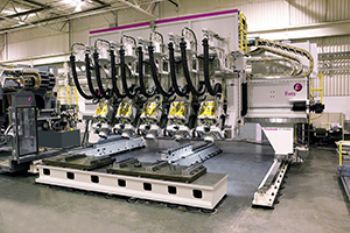
For companies that supply aircraft manufacturers with parts made from difficult-to-machine materials, production delays can mean order cancellations and the transfer of work to better-equipped suppliers — such as those using machines from Fives Cincinnati, which produces machining centres, composite-fibre placement systems and multi-spindle profilers at its Hebron (Kentucky) plant.
Indeed, the company has more than 650 profilers in use world-wide (it says there is not a commercial aircraft flying that has not been ‘touched’ by a Cincinnati profiler).
Available in three- and five-spindle gantry configurations, the latest generation of these ‘powerful giants’ — the XTi Profiler — has been designed to process multiple materials. There are 7,000rev/min spindles for cutting aluminium and steel and high-torque (2,523Nm) spindles for processing titanium and other hard alloys at metal removal rates (MRRs) of more than 100in3/min.
These massive machines — with 4,267mm of X-axis travel (expandable in increments of 3,658 mm), 3,683mm in Y, and 711mm in Z — are setting new MRR records thanks to the use of the optional KM4X100 spindle connections from Kennametal (
www.kennametal.com).
While machine tool builders build milling and profiling centres that feature improved stiffness and damping on spindles, the weakest point historically has been the spindle connection — the ‘handshake’ between the machine tool and the cutting tool that determines how much material the machine can safely remove in a given operation.
This is because it must withstand high loads while maintaining its rigidity to avoid the onset of chatter. An 80mm-diameter indexable-insert helical cutter with a 250mm projection from the spindle face generates 4,620Nm of bending moment and less than 900Nm of torque when removing 360cm3/min of Ti6Al4V at a radial depth of cut of 12.7mm and an axial depth of cut of 63.5mm.
Together with Fives Cincinnati applications engineer Mike Malott, Robert Snodgrass began evaluating KM4X about four years ago. “It allowed us to start thinking that a stiffer spindle helps to meet customer demand for more-effective metal cutting and increased throughput.
Typical aero-structure components start out as forgings, with much of the material being removed to achieve finished-part specifications. The buy-to-fly ratio — the weight you buy in raw material versus the weight that flies in finished form — ranges from 4:1 to 8:1 or more, depending on the component.”
Due to the limitations of the machine structure and tool-spindle connection, first-generation Cincinnati profilers achieved an MRR of 4in3/min in titanium. With the XT generation of Cincinnati profilers and face-contact HSK 125 spindle connections, the MRR increased to 50in3/min; with the KM4X100 interface, it doubled.
Mr Snodgrass says: “Even at a 100in3/min, our benchmark testing for the XT profilers using the KM4X was well below the machine’s theoretical limits for bending-moment resistance. Previous-generation tests used CAT60-taper tool-holders, which — compared to 50-taper versions — are like driving a tank versus an SUV. The KM4X achieved double the metal removal rates of the 60-taper tool-holder.
Ken Wichman, Fives Cincinnati product manager, says: “This changes spindle and machine design massively. Many gantry machines have manual tool exchange, even though automatic tool exchange and storage is available. The enhanced bending-moment resistance of the KM4X allows lighter tooling to be used when compared to a CAT or HSK tool with an equivalent bending-moment resistance.”
Fives Cincinnati vice-president Mark Logan said: “Not only is a more powerful spindle connection like KM4X changing new-machine design, it also can be a significant boost for existing machines in the field. This gives us the chance to offer a notable upgrade in retrofits while still pushing the limits on profiler models to come.”